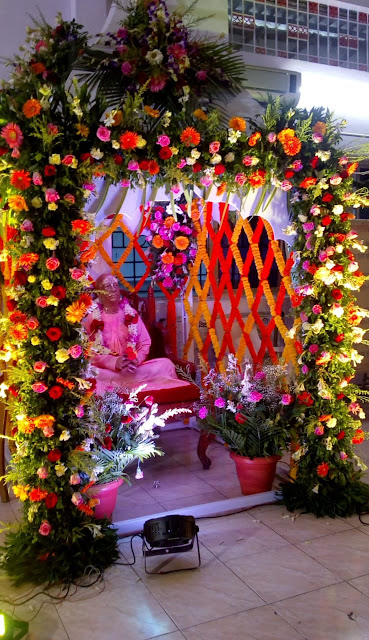Wish you a very happy Krishna Janmashtami!! ❤🙏
With the motivation I have got from the love from you all on the last blog, I am here with the " Janmashtami special blog" with some lesser known and spiritual facts about shree krishna and and some shotsrelated to shri krishna by me. So, this one is gonna be a mixture of science, spirituality, religion and art ( photography).
( Janmashtami darshan of Sri Sri Radharasbihari ji, ISKCON Raipur 🙏 )
So, do you think that krishna is only there in Hinduism or is he there in other religions or cultures too? Let's find out....
Jainism
The Jainism tradition lists
63 Śalākāpuruṣa or notable figures which, amongst others,
includes the twenty-four Tirthankaras (spiritual
teachers) and nine sets of triads. One of these triads is Krishna as the Vasudeva, Balarama as the Baladeva,
and Jarasandha as the Prati-Vasudeva.
In each age of the Jain cyclic time is born a Vasudeva with an
elder brother termed the Baladeva. Between the triads, Baladeva upholds
the principle of non-violence, a central idea of Jainism. The villain is
the Prati-vasudeva, who attempts to destroy the world. To save the
world, Vasudeva-Krishna has to forsake the non-violence
principle and kill the Prati-Vasudeva.
Buddhism
The story of Krishna occurs in
the Jataka tales in Buddhism.[252] The Vidhurapandita Jataka mentions Madhura (Sanskrit:
Mathura), the Ghata Jataka mentions Kamsa, Devagabbha (Sk:
Devaki), Upasagara or Vasudeva, Govaddhana (Sk: Govardhana), Baladeva
(Balarama), and Kanha or Kesava (Sk: Krishna, Keshava).[253][254]
Like the Jaina versions of the Krishna legends, the Buddhist versions such as one in Ghata Jataka follow the general outline of the story,[255] but are different from the Hindu versions as well.[253][78]
Other
- Krishna is mentioned as Krishna Avtar in the Chaubis Avtar, a composition in Dasam Granth traditionally and historically attributed to Guru Gobind Singh.[263]
- Baháʼís believe that Krishna was a "Manifestation of God", or one in a line of prophets who have revealed the Word of God progressively for a gradually maturing humanity. In this way, Krishna shares an exalted station with Abraham, Moses, Zoroaster, Buddha, Muhammad, Jesus, the Báb, and the founder of the Baháʼí Faith, Bahá'u'lláh.[264][265]
- Ahmadiyya, a 20th-century Islamic movement, consider Krishna as one of
their ancient prophets.[266][267][268] Ghulam Ahmad
stated that he was himself a prophet in the likeness of prophets such as
Krishna, Jesus, and Muhammad,[269] who had come to
earth as a latter-day reviver of religion and morality.
- Krishna was canonised by Aleister Crowley and is recognised as a saint of Ecclesia Gnostica Catholica in the Gnostic Mass of Ordo Templi Orientis.[273][274]
- Chinese Buddhism, Taoism and Chinese folk religion, the figure of Krishna has been amalgamated and merged with that of Nalakuvara to influence the formation of the god Nezha, who has taken on iconographic characteristics of Krishna such as being presented as a divine god-child and slaying a nāga in his youth.[261][262]

Why is he blue or blue skinned??
Blue is the color of all-inclusiveness. You will see in the existence, anything that is vast and beyond your perception generally tends to be blue, whether it is the ocean or the sky. Anything which is larger than your perception tends to be blue because blue is the basis of all-inclusiveness. It is based on this that so many gods in India are shown as blue-skinned. Shiva has a blue skin, Krishna has a blue skin, Rama has a blue skin. It is not that their skin was blue. They were referred to as blue gods because they had a blue aura.
The bluish tinge in Lord
Krishna’s skin is not the colour of the material body but the eternal spiritual
body of the Lord that emits blue aura. According to Bhagavad Gita, the blissful
form of Lord Krishna is visible only to pure devotees. He may have bewildered
the non-devotees, but those who offered pure devotional service to Him had
always seen Him in his blue blissful form.
What does peacock feathers on his crown signify?
Even though Lord Krishna also manifested inside His own
'Maya', He was never controlled or disturbed by its powers.
The feathers of peacock exemplify Lord's Maya in a manner
which human mind can try to grasp. The brilliant colors of peacock do not arise
from the correspondingly colored pigments. Instead, they arise from the
phenomenon called 'structural coloration'. The light waves entering the
different thickness of keratin layers on peacock feathers get out of phase and
undergo interference. The resulting light wave patterns give the beautiful play
of colors which the human eyes see. The 'actual' color is just deep brown
pigment which occurs in the background of these keratin layers.
Thus, Lord Krishna wears a brilliant example of His own Maya
in His crown and stimulates our intelligence to understand the fact that the
whole universe is a diverse manifestation of one single divinity. Thus, we are
also supposed to understand the nature of Maya continuously during our life so
that we do not get carried away and suffer due to its influence. If we also
start wearing this idea in our mind, like Krishna wears its symbolically in His
crown, then we can also enjoy this life in the manner Lord Krishna wants us to
live.
Sources : https://en.wikipedia.org/wiki/Krishna , https://isha.sadhguru.org/in/en/wisdom/article/why-is-krishna-blue , https://www.downtoearth.org.in/news/health/did-lord-krishna-really-have-blue-skin--55392
Photographist : Kamya 🌸
I think you have loved these shots and the knowledge given if you have scrolled till here. I'd be much grateful for any comments, feed backs or suggestions you might have for me. And I would love to know which shot or fact you liked the most :)
See you in the next blog soon, till then,
Have a wonderful day, take care and....
always remember to love yourself first!! ❤
Let there be love, light, happiness and laughter in your life with Lord Krishna’s blessings.
Jai shree Krishna 🙏❤
























